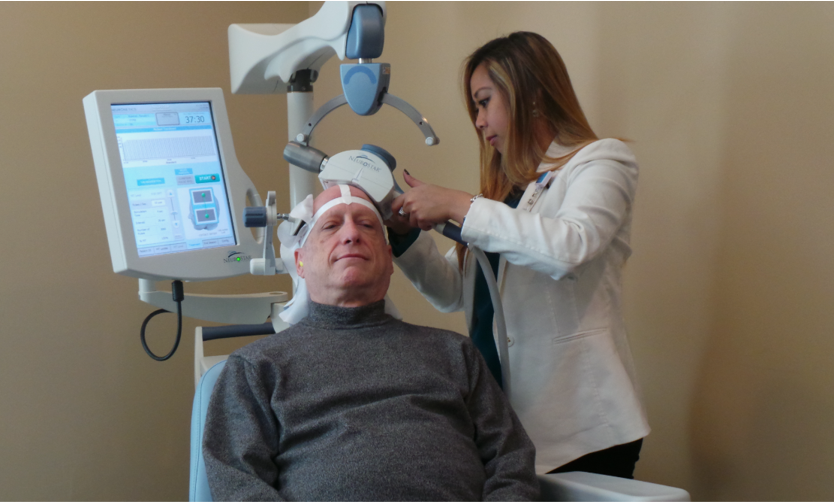

Post-Traumatic Stress Disorder (PTSD) can deeply affect a person’s life, making it difficult to manage daily tasks, relationships, and emotions. Traditional treatments, like therapy and medication, don’t always work for everyone. This is where Transcranial Magnetic Stimulation (TMS) therapy comes in.
TMS therapy is a non-invasive, FDA-approved treatment that offers new hope for people with PTSD. It uses magnetic pulses to stimulate certain parts of the brain. So, let us explore how TMS therapy supports mental health recovery in patients with PTSD.
What is PTSD?
PTSD is a mental health disorder that occurs after someone experiences or witnesses a traumatic event, like war, natural disasters, accidents, or abuse. Symptoms of PTSD can include:
- Intrusive thoughts or memories: People may experience flashbacks or nightmares.
- Avoidance: They might avoid places, people, or activities that remind them of the trauma.
- Hyperarousal: Feeling jumpy, irritable, or easily startled.
- Negative thoughts and moods: Feeling disconnected from others, guilty, or numb.
PTSD can be very difficult to manage, especially without the right treatment. Traditional treatments like cognitive behavioral therapy (CBT) and medication work for some people but not for others. This is where TMS therapy can make a difference.
What is TMS Therapy?
Transcranial Magnetic Stimulation (TMS) is a non-invasive procedure that uses magnetic fields to stimulate nerve cells in the brain. A doctor places a device on the scalp, and this device sends magnetic pulses to areas of the brain that control mood and emotions.
These magnetic pulses help to improve brain function, especially in people who have mental health disorders like depression and PTSD. TMS therapy is painless, and the patient is awake during the entire session.
A typical treatment lasts about 30 to 60 minutes, and most people receive treatment five days a week for several weeks. Many patients begin to notice improvements after just a few sessions.
How TMS Therapy Helps Patients with PTSD
TMS therapy offers a unique approach to treating PTSD by targeting specific areas of the brain involved in emotional regulation and fear response. Here’s how it helps patients manage their symptoms and supports recovery:
Stimulates Underactive Areas of the Brain
Research shows that people with PTSD have certain areas of the brain that are underactive, especially the prefrontal cortex. This area is important for managing emotions, fear responses, and decision-making.
TMS therapy targets this part of the brain and helps to “wake it up” by sending magnetic pulses. This stimulation can reduce symptoms of PTSD, such as intrusive thoughts and emotional numbness.
Reduces Hyperactivity in the Amygdala
The amygdala is the part of the brain responsible for processing fear and emotional responses. In patients with PTSD, the amygdala is often overactive, leading to heightened fear and anxiety.
TMS therapy can help to calm the amygdala, reducing the fear and hypervigilance that people with PTSD often experience.
Improves Mood and Emotional Regulation
TMS therapy can also help regulate mood by stimulating the brain’s circuits involved in emotional control. This makes it easier for patients to manage their emotions.
It reduces mood swings, irritability, and feelings of guilt or shame. For man


Who is a Good Candidate for TMS Therapy?
TMS therapy is typically recommended for people with PTSD who:
- Have not found relief from traditional treatments like therapy or medication.
- Want a non-invasive, drug-free treatment option?
- Are looking for a treatment with minimal side effects.
It’s important to talk to a healthcare professional to determine if TMS therapy is the right choice. At places like the Delray Center for Healing, a Comprehensive Outpatient Mental Health Treatment center, experts can evaluate your condition and help you decide if TMS is suitable for you.
Some people may not be good candidates for TMS therapy, such as those with metal implants in their heads or those who have a history of seizures.
The Benefits of TMS Therapy for PTSD
Here are some key benefits of TMS therapy that make it a promising treatment option for individuals struggling with PTSD.
Non-invasive and Drug-Free
Unlike some PTSD treatments that involve medication, TMS therapy is a non-invasive, drug-free option. This is a significant benefit for people who do not want to deal with the side effects of psychiatric medications, such as weight gain, drowsiness, or sexual dysfunction. TMS therapy allows patients to experience symptom relief without adding new challenges from medications.
Minimal Side Effects
TMS therapy has very few side effects. The most common side effect is mild discomfort or a headache at the site where the device is placed, but this usually goes away after a few sessions. There is no need for anaesthesia or sedation, and patients can resume their daily activities immediately after each session.
Works When Other Treatments Fail
For people who have tried traditional treatments without success, TMS therapy can be a game-changer. It offers a new way to treat PTSD that doesn’t rely on medications or talk therapy alone. Many people find that TMS therapy significantly reduces their symptoms, even if other treatments haven’t worked in the past.
What to Expect During TMS Therapy
If you are considering TMS therapy for PTSD, here’s what you can expect:
Initial Consultation:
You’ll meet with a doctor who will evaluate your symptoms and medical history to see if TMS is right for you.
Treatment Sessions:
You’ll sit in a comfortable chair while the doctor places a coil on your head. The coil sends magnetic pulses to stimulate the brain. You’ll be awake and can relax during the session.
Regular Appointments:
Most people have TMS therapy sessions five times a week for four to six weeks. Each session lasts about 30 to 60 minutes.
Monitoring Progress:
Your doctor will monitor your progress throughout the treatment. Many people start to notice improvements in their symptoms after just a few sessions, but full benefits may take several weeks.


The Effectiveness of TMS Therapy for PTSD
Several studies have shown that TMS therapy can significantly reduce PTSD symptoms. One study found that nearly 70% of patients experienced a decrease in symptoms after completing a course of TMS therapy. These improvements included reduced anxiety, fewer intrusive thoughts, and better emotional control.
Conclusion
TMS therapy offers hope to people with PTSD who have not found relief from traditional treatments. By targeting specific areas of the brain, TMS can help regulate mood, reduce fear responses, and improve overall brain function.
The non-invasive, drug-free nature of TMS therapy makes it a valuable option for those seeking alternative treatments for PTSD. If you or a loved one is struggling with PTSD, talk to a healthcare provider to see if TMS therapy might be right for you.








